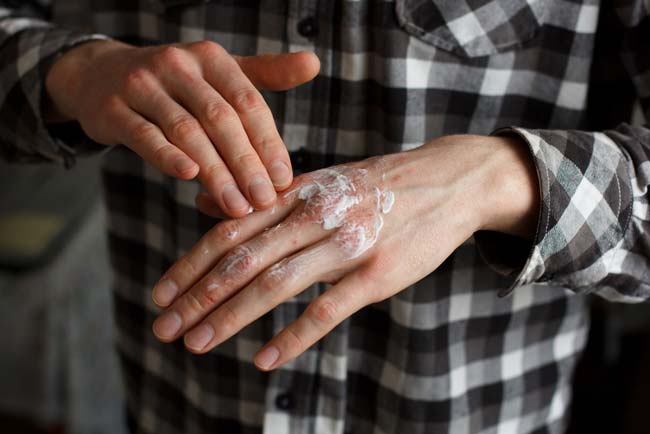More than 7.5 million Americans have this condition, and more than 150,000 new cases are diagnosed each year. Yet few people are even familiar with psoriasis. Let’s change that.
When your body and skin function normally, skin cells develop over a period of weeks. When you have psoriasis, though, that skin cell production goes into overdrive and new cells are produced daily. Because of this, those cells build on the skin — and scaly patches often develop.
These patchy sections of skin are more than annoying. They can also be dry, itchy, and even painful.
Let’s take a deeper dive into the basics of psoriasis.
Who is affected?
The answer is simple—anyone can be affected. The condition usually emerges in people between the ages of 15 and 35 and affects both genders and all races.
It’s also not uncommon for the condition to develop later in life, between ages 50 and 60.
What are the causes?
No one is actually quite sure, but something overstimulates the white blood cells in the body, which think your body is under attack. In turn, they release a protein that causes inflammation.
This inflammation speeds up the process of producing new skin cells.
Certain factors are thought to trigger this skin condition, including infections, excess stress, certain medications, sunburn, excess alcohol consumption, and smoking.
What are the signs?
While we discussed the basics of how psoriasis works above, the symptoms of the condition vary depending on the type.
There are five types:
- Plaque—This is the most common type of psoriasis, representing about 80 to 90 percent of all cases, according to the American Academy of Dermatology. It causes patches of thick, raised skin (plaques) that vary in size and may be covered in a dry, thin coating. These patches typically develop on the scalp, elbows, knees, or back.
- Guttate — This type causes tiny bumps to develop suddenly on the skin, covering the torso, legs, arms, and sometimes the face. These bumps are small and scaly and typically pink in color. They’re usually temporary, clearing up in a matter of weeks or months.
- Inverse—This type of psoriasis develops in areas where skin comes into contact with other skin, like the armpits and genitals. Those with inverse psoriasis often experience smooth, raw-looking patches of skin that are sore and painful.
- Pustular — This type of psoriasis is exactly as it sounds. Those with this type develop pus-filled bumps, typically only on the hands and feet. The skin can become red, swollen, and painful.
- Erythrodermic — This type of psoriasis is the most serious and can be life-threatening. When erythrodermic psoriasis occurs, the skin on most of the body appears burnt, and a person may develop chills, a fever, muscle weakness, a rapid pulse, and severe itchiness. Hypothermia can also set in, making immediate medical attention essential.
The types aren’t exclusive, so a person may develop or have more than one over the course of a lifetime. In fact, most people who develop erythrodermic psoriasis have another type of psoriasis, too.
What parts of the body does psoriasis impact?
You might think psoriasis is only a skin condition. But that’s not true.
The condition can directly impact all areas of the skin, along with the nails. But psoriasis has also increased your risk of developing many other health conditions, impacting all body areas.
One of the most common related issues is psoriatic arthritis — a type of arthritis that occurs when you have psoriasis. How are they related, you may wonder? Well, both conditions are caused by inflammation.
Psoriatic arthritis can cause swollen and painful joints, back or neck pain, and general fatigue, among other symptoms.
Psoriasis also increases the risk of developing:
- Eye issues, including blurry vision, floaters, and dry eyes
- Crohn’s disease
- Weight gain or loss
- Mental health issues
- Periodontal disease
- Kidney disease
To limit the effects of psoriasis on the body, it’s important to promptly seek diagnosis and treatment when symptoms develop. Depending on the type of psoriasis, treatment may include oral and topical medications, as well as light therapy.
Are you wondering whether your skin changes may be caused by psoriasis? Call Erlanger Dermatology at 423-778-5693 or click HERE to see a full list of our dermatologists and book an appointment.







